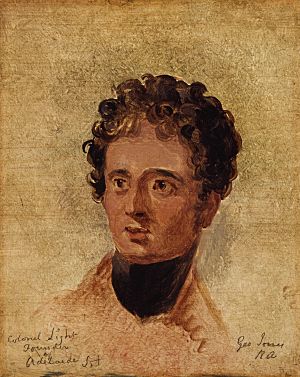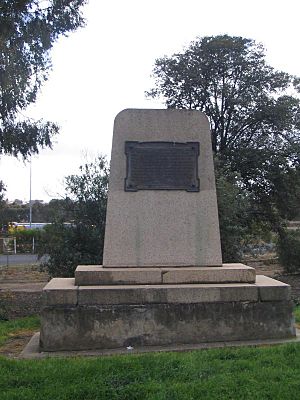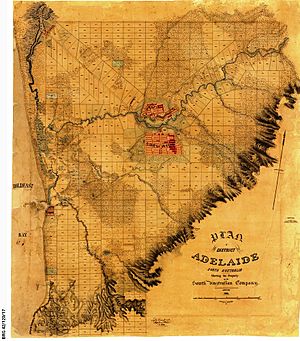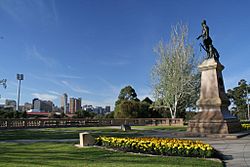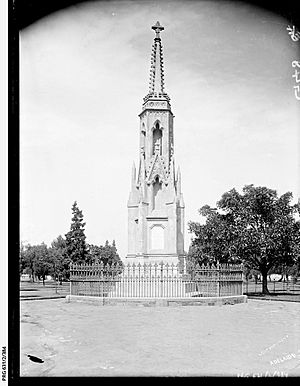William Light facts for kids
William Light (born 27 April 1786 – died 6 October 1839), also known as Colonel Light, was a British-Malayan naval and army officer. He became the first Surveyor-General of the new British Province of South Australia. He is famous for choosing the location of Adelaide, the capital city of South Australia. He also designed its street layout, six city squares, gardens, and the unique figure-eight Adelaide Park Lands. This plan is sometimes called Light's Vision.
William Light was the oldest son of Captain Francis Light, who founded Penang (now in Malaysia), and Martinha Rozells.
Contents
Early Life and Education
William Light was born in Kuala Kedah, Kedah, which is now part of Malaysia, on 27 April 1786. His father, Captain Francis Light, founded and was in charge of Penang. His mother, Martinha Rozells, had Portuguese, French, Siamese, or Malay heritage. Because of his mixed background, William was considered "Eurasian" in colonial times. This meant he did not have the same rights as British people. He was baptised on 31 December 1786.
William lived in Penang until he was six years old (1793). Then, he was sent to Theberton, a village in Suffolk, England, to be educated by his father's friends, George and Anne Doughty. He never saw his parents again. Although his father paid for his education, William did not inherit his father's large fortune. The money was lost due to poor management after Francis's death in 1794.
William grew close to the Doughty family. Later, he named his house in Adelaide after their home. He received a good education and quickly learned to speak Spanish and French. He also showed a talent for drawing, watercolour painting, and music. In London, he was known as a wealthy person from the East Indies and even met King George IV when he was still the Prince of Wales.
Military Career and First Marriage
Around 1799, when he was 13 or 14, William Light joined the Royal Navy. He served for two years and left as a midshipman, which is a junior officer rank.
After being held as a civilian in France from 1803 to 1804, he went to Calcutta (India) for his sister Mary's wedding in March 1805. He stayed in India until November 1806 before returning to Europe. On 5 May 1808, he joined the British Army as an officer in the 4th Dragoons regiment. He was promoted to lieutenant in April 1809 while on his way to Spain. There, he fought bravely against Napoleon's forces in the Peninsular War from 1809 to 1814. He worked under the Duke of Wellington, helping with mapping, scouting, and communication. He was known for his bravery and kindness, and Wellington thought highly of him. After the war, he served as a captain in the infantry in different parts of Britain, including the Channel Islands, Scotland, and Ireland.
After leaving the army with the rank of major, Light married Miss E. Perois in Derry, Ireland, on 24 May 1821. They lived in Paris, Italy, and Sicily for a few years, enjoying artistic and literary circles. Sadly, his young wife died during this time.
In 1823, he returned to Spain to fight against the French invasion. He served as an aide-de-camp to Sir Robert Thomas Wilson, who had gathered an international force to help the "Liberales" in their fight against King Ferdinand VII. Light volunteered as a private soldier but was quickly made a Lieutenant-Colonel. He was badly wounded in A Coruña, Spain.
Second Marriage and Travels
Returning to England in 1824, Light met Mary Bennet, a beautiful and wealthy 19-year-old. She was the daughter of the 3rd Duke of Richmond. They met in London and married quickly on 16 October 1824. They traveled across Europe, spending time in France, Switzerland, and Italy (especially Rome). In 1828, Light published his book Views of Pompeii.
After returning to England, Light bought a yacht and sailed around the Mediterranean Sea for several years. In 1830, they went to Egypt. There, Light met people who were planning a new colony in Australia. Light drew many sketches, and Mary studied Egyptology. She became good friends with the Egyptologist John Gardner Wilkinson. The couple also became friends with Muhammad Ali Pasha, who was the ruler and founder of modern Egypt.
Light helped Muhammad Ali build a modern navy. He sailed his own yacht to England to help recruit British men for the Pasha's navy. He captained the paddle steamer Nile from London to Alexandria, arriving in September 1834. John Hindmarsh had prepared the ship and traveled as a passenger. Hindmarsh later became the ship's captain.
Around this time, Light began a relationship with Maria Gandy, who was 21 years old. She remained his companion for the rest of his life.
Surveyor-General of South Australia
By 1835, plans were complete for starting the new British Province of South Australia. This colony was meant to be self-supporting and free, based on the ideas of Edward Gibbon Wakefield.
Light had given Hindmarsh a letter of introduction to Colonel Charles James Napier, who was supposed to be the new colony's Governor. However, Napier wasn't interested. When Hindmarsh heard this, he quickly went to London and asked for the job himself. Napier suggested that Light should be Governor, but Hindmarsh had already been promised the role. Light returned to London in January 1836 and was appointed Surveyor-General of South Australia on 4 February.
On 1 May 1836, Light sailed for South Australia with Maria Gandy, two of her younger brothers, and some of his survey team. They were on the survey ship Rapid, part of the "First Fleet of South Australia" of ten ships. The Rapid reached Kangaroo Island on 17 August 1836.
Starting on 23 September, Light explored Gulf St Vincent. He sailed past Rapid Bay and up to Port Adelaide before returning to Rapid Bay. Other ships arrived, bringing colonial officers who were eager to know where the settlement should be. Light suggested that the ships land at Holdfast Bay for a while, while he explored further. At Rapid Bay, his group met Indigenous Australians (from the Southern Kaurna tribes) for the first time and formed a friendly relationship with them.
Light then sailed to Port Lincoln on Spencer Gulf, but found the area unsuitable because it lacked surface water and was difficult to navigate. On 18 December, he decided on the site of Adelaide for the new capital. He then went north to survey the coast for a good harbour. HMS Buffalo arrived at Holdfast Bay on 28 December. On that same day, Governor Hindmarsh landed and officially started the colonial government, which is now celebrated as Proclamation Day.
Designing Adelaide
Light's job was to survey the harbours and land to find the best place for the first town. He was the first to accurately map the Port Adelaide River. Then, he chose the location for Adelaide and designed its layout. He managed to plan and establish the city in just eight weeks.
Choosing the Location
Light chose a site that crossed the River Torrens, which the local Kaurna people called Yatala. One reason for his choice was that he noticed the Adelaide Hills would bring more rainfall to the Adelaide plain. This suggested good conditions for avoiding drought. Other possible settlement sites had been rejected. The chosen site had challenges, but Light wrote that he picked it "because it was on a beautiful and gently rising ground, and formed altogether a better connection with the river than any other place".
Despite the natural advantages, Light faced opposition. Governor Hindmarsh wanted the city closer to the Murray River mouth near Encounter Bay. Some settlers also disliked the distance from the port. The arguments against Light's plan came to a head at a meeting on 10 February. Light wrote a letter explaining his choice, praising the good soil, large plains, good sheep grazing, plenty of fresh water all year round, easy access to the harbour, and closeness to the Murray River, as well as the beauty of the land.
In his letter, Light added a personal note: "The reasons that led me to fix Adelaide where it is I do not expect to be generally understood or calmly judged of at present. My enemies however, by disputing their validity in every particular, have done me the good service of fixing the whole of the responsibility upon me. I am perfectly willing to bear it, and I leave it to posterity and not to them, to decide whether I am entitled to praise or to blame". In March 1837, Light's choice was supported by a vote.
After disagreements between Hindmarsh and Resident Commissioner Fisher, Hindmarsh formally complained about the slow progress of the surveys, while also making Light's work harder. In July 1837, Hindmarsh was recalled.
Adelaide's City Plan
When Light designed Adelaide, his plans included surrounding the city with 2,332 acres (9.4 km²) of park. He also set aside 32 acres (0.13 km²) for one of the world's first public cemeteries, West Terrace Cemetery.
Light called his unique figure-eight of open space "Adelaide Park". Over time, people started calling it "Adelaide Park Lands".
Light placed the city on both the north and south sides of the river. He avoided areas that flooded and used the natural shape of the land well. His plan divided the land into 1042 square one-acre lots: 342 acres (1.38 km²) north of the Torrens (North Adelaide) and 700 acres (2.8 km²) to the south (South Adelaide, now the city centre). Light's Plan also saved 42 acres (0.17 km²) for town squares (38 acres) and government buildings.
Adelaide's distinct grid pattern is not entirely new; similar patterns existed in ancient Greece and Spanish colonial cities. These often included a grid with a main street and a central square. While other cities like Philadelphia had five squares, Light's Plan has six public squares. There is no proof that Light copied any specific cities or rules. His way of combining planning principles for a beautiful and healthy city with the natural landscape is unique.
"Light's vision" was to create a city that worked well with nature. The colonisation of South Australia was meant to be a social experiment, influenced by many thinkers like Jeremy Bentham and Edward Gibbon Wakefield.
The oldest known version of Light's plan was drawn in 1837 by a 16-year-old draughtsman, following Light's instructions. A later original version drawn by Light himself in 1838, a map of Adelaide, still exists.
After Resignation
By this time, Light had spent a lot of his own money on his work and was becoming unwell. He resigned on 21 June 1838, after being asked to survey 150 square miles (388 km²) in a week and refusing to use less accurate methods for country surveys. On 3 September, he started his own company, Light, Finniss & Co., with other surveyors. They offered services for buying city and country properties. Light surveyed the Port River and the town of Glenelg. However, he had to resign from his company due to his worsening health.
His old war wounds bothered him, and he developed tuberculosis. Despite this, he enjoyed growing good crops of vegetables in his garden.
On 22 January 1839, the Land and Survey Office, along with Light's and Resident Commissioner James Hurtle Fisher's huts, and the first Government House, burned down. This fire destroyed many early records of the province and many of Light's belongings. It was thought to be arson. Light had just started preparing his journals, which he had kept for 30 years, for publishing. He had left cases of papers for safety in the survey office, and most of his journals were lost, which was a great loss for him.
Other Activities and Personal Life
Light spoke several languages and was a talented painter and sketcher. Many of his watercolour paintings were published in London in 1823 and 1828. A number of his works, including an unfinished self-portrait, are in the collection of the Art Gallery of South Australia. Others are kept in the State Library of South Australia and the Adelaide Town Hall. He often sold his artworks to support himself, but many were lost in the 1839 fire.
In December 1837, Light led an exploration from Adelaide. He discovered and named the Barossa Range, which gave its name to the famous Barossa Valley.
Maria Gandy
Maria Gandy (born 23 November 1811 – died 14 December 1847) was William Light's companion for the rest of his life. They lived together with Maria's younger brothers.
They first lived in a bark house, which was completely destroyed by the 1839 fire, along with all their belongings. Later, they lived in a four-room brick cottage built by William Gandy, which they named Theberton House. This was after Light's childhood home, Theberton Hall in Suffolk.
After Light's death, Maria Gandy married Dr George Mayo on 7 July 1840. They had four children. Maria Mayo died of tuberculosis in 1847, at the age of 36. She was buried in an unmarked grave.
On 23 November 2011, the 200th anniversary of her birth, the Maria Gandy Bicentennial Memorial was unveiled in Thebarton. This memorial honours Maria for her roles as a pioneer, settler, carer, and mother.
Historians today see Maria Gandy as someone who gave strength to the sickly Light, helping him achieve his goals even though many people in society looked down on their relationship.
Later Life, Death, and Burial
Maria Gandy cared for Light for three years while he was ill with tuberculosis. He died on 6 October 1839 in Adelaide, at the age of 53. The only Anglican clergyman in South Australia at the time, Reverend Charles Beaumont Howard, refused to visit him because of his relationship with Maria Gandy.
On 10 October 1839, Light's funeral service took place at Trinity Church on North Terrace. After the service, a procession walked to the nearby Light Square. Hundreds of people attended, many openly weeping. A gun salute was fired, and the flag at Government House was lowered to half-mast.
Maria Gandy was in charge of Light's estate and paid for the funeral. Light's body was buried at Light Square. More than 3,000 people attended the burial, including many who had previously been against him. The only document written by Light that survived was his will.
A few days later, Light's friends met to raise money for a memorial. The foundation stone for the memorial was laid in 1843, and the monument itself was finished in February 1845. It was a five-sided structure made of freestone and topped with a Gothic cross 45 feet (13.7 m) high.
Legacy and Recognition
The plan of the city of Adelaide is a lasting reminder of Light's brilliant work. It has been praised both in the past and in more recent times.
Light's Vision
The most famous memorial to Light is the statue on Montefiore Hill. It is known as Light's Vision and points south towards the River Torrens and the city centre.
The design for the statue was chosen in 1904. The statue of Light was unveiled on 27 November 1906 in its first location at the northern end of Victoria Square. The ceremony was led by the Mayor of Adelaide, Theodore Bruce, and attended by many important people. The Governor of South Australia, Sir George Le Hunte, gave a speech praising Light, and the crowd cheered.
The statue was moved in 1938 to its current spot on Montefiore Hill to mark 100 years since Light's death. It was renamed "Light's Vision". It is said that Light stood on Montefiore Hill when he planned the city, but this is not confirmed.
The plaque on the front of the statue reads: "Colonel William Light First Surveyor General; Fixed the site and laid out the city of Adelaide in 1836; Erected by citizens; 1906." Several other plaques have been added to the back.
Other Ways Light is Remembered
Light's achievements are remembered in many ways:
- Light Square, Adelaide, where he was buried. He is the only person legally buried within Adelaide's city centre.
- His grave monument. The original was a five-sided sandstone structure with a Gothic cross. It was replaced in 1905 with a new design featuring a bronze theodolite on a tall column of red granite. This new monument was unveiled in June 1905. The grave and monument were updated in 1985–86 and again in 2008.
- Light Passage, in the Port River.
- The Colonel Light Hotel, established in 1849 and renamed in 1888.
- The Light River, which flows for 164 km (102 mi) to the Gulf St Vincent.
- The County of Light, named after the Light River in 1842.
- In 1905, Light's self-portrait in oils was given to the Art Gallery.
- The garden suburb of Colonel Light Gardens, named in the 1920s.
- A memorial at Rapid Bay, a stone pile marking Light's first mainland survey in 1836. It was unveiled in 1928.
- The Colonel Light Survey Marker, an obelisk and plaque, marks the spot where Light's office and huts once stood. It was unveiled in 1929 and is now outside the new Royal Adelaide Hospital.
- The State Survey Mark at the northern end of Victoria Square. This mark shows where the first peg for the city survey was placed by Light on 11 January 1837. It is the main reference point for all other survey marks in South Australia.
- A plaque commemorating Light's cottage was unveiled in 1927 in Hindmarsh, near where Theberton House once stood.
- Light Square in the Adelaide suburb of Marion, with four stone piles remembering the early survey of the village.
- William Light School, now called Plympton International College.
- A plaque on the Jubilee 150 Walkway on North Terrace, placed in 1986.
- Each April, the Adelaide City Council celebrates Light’s birthday. This tradition began in 1859 when friends of Light gave a silver bowl to the mayor and council, asking them to toast Light each year. A portrait of Light from 1836 also hangs in the Council Chamber.
- A portrait of Light also hangs in the National Gallery in London.
New 1837 Watercolour Discovered 2019
In September 2019, a watercolour painting by Light was found in a garage. It was painted between January and April 1837 and shows the site of the Land/Survey Office and Light and Fisher's huts, with Mount Lofty in the background. This painting is considered very important because it is one of the earliest pictures of Adelaide. It was later sold to a private collector.
In the Arts
Stage
In October 2019, a play called Light was created and performed by Malaysian artists. It explored the lives of William Light and his father, Francis, and their important roles in the history of Penang and Adelaide. The play also looked at the lives of the women in their families and how global politics, like the rise of the British Empire, influenced them. It focused on family and Light's own feelings, showing him as a successful but also lonely person.
Common Misunderstandings
Port Adelaide
Many people mistakenly think Light's plan only included the city centre of Adelaide. However, he also planned 29 Town Sections for the harbour area of Port Adelaide, which are often forgotten as part of his original design.
Christchurch, New Zealand
Sometimes, people wrongly claim that Light also designed the city centre of Christchurch in New Zealand. This is not possible because Light died in Adelaide in 1839, while Christchurch was only planned in March 1850 by an Englishman named Edward Jollie.
See also
 In Spanish: William Light para niños
In Spanish: William Light para niños



